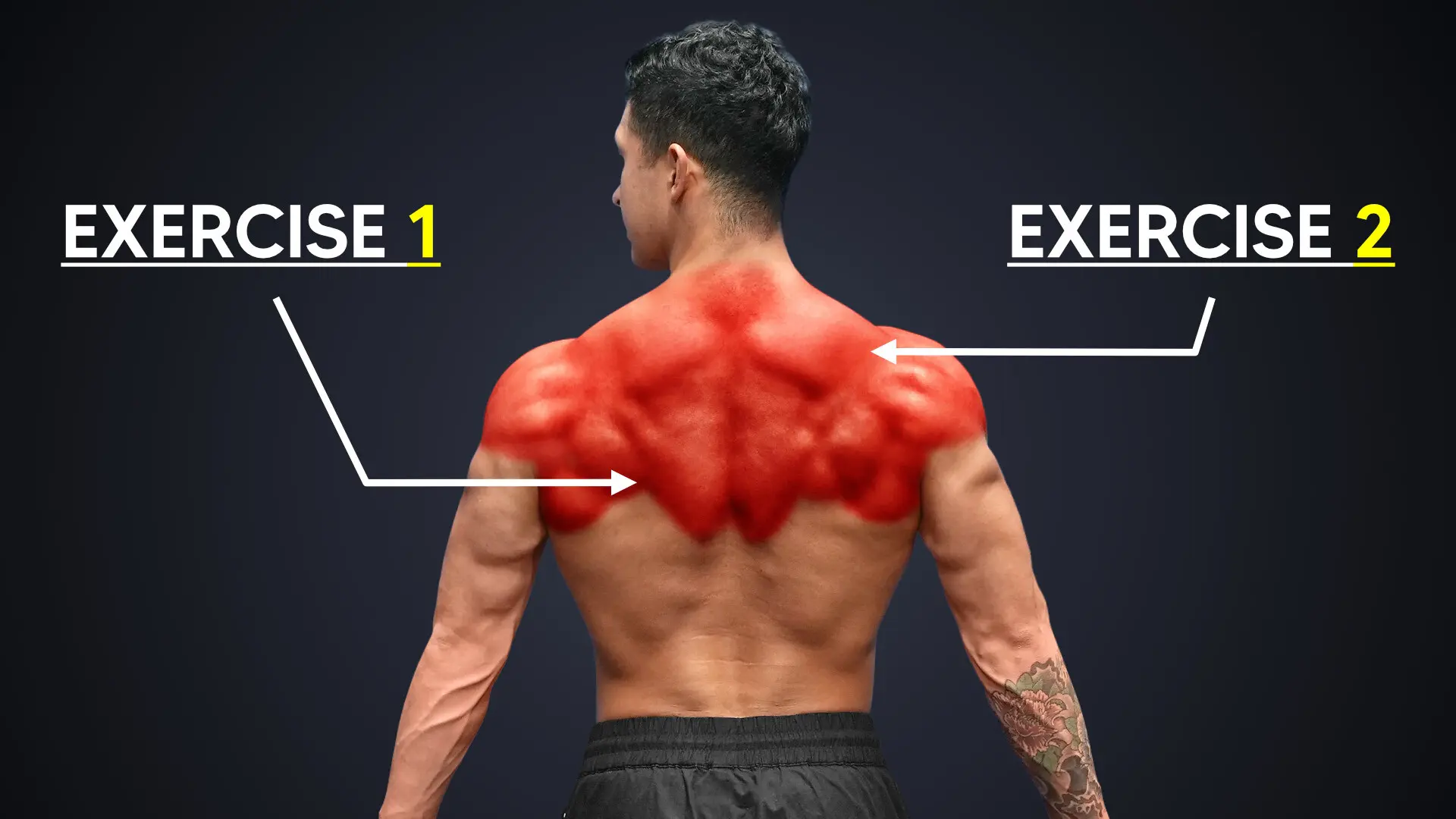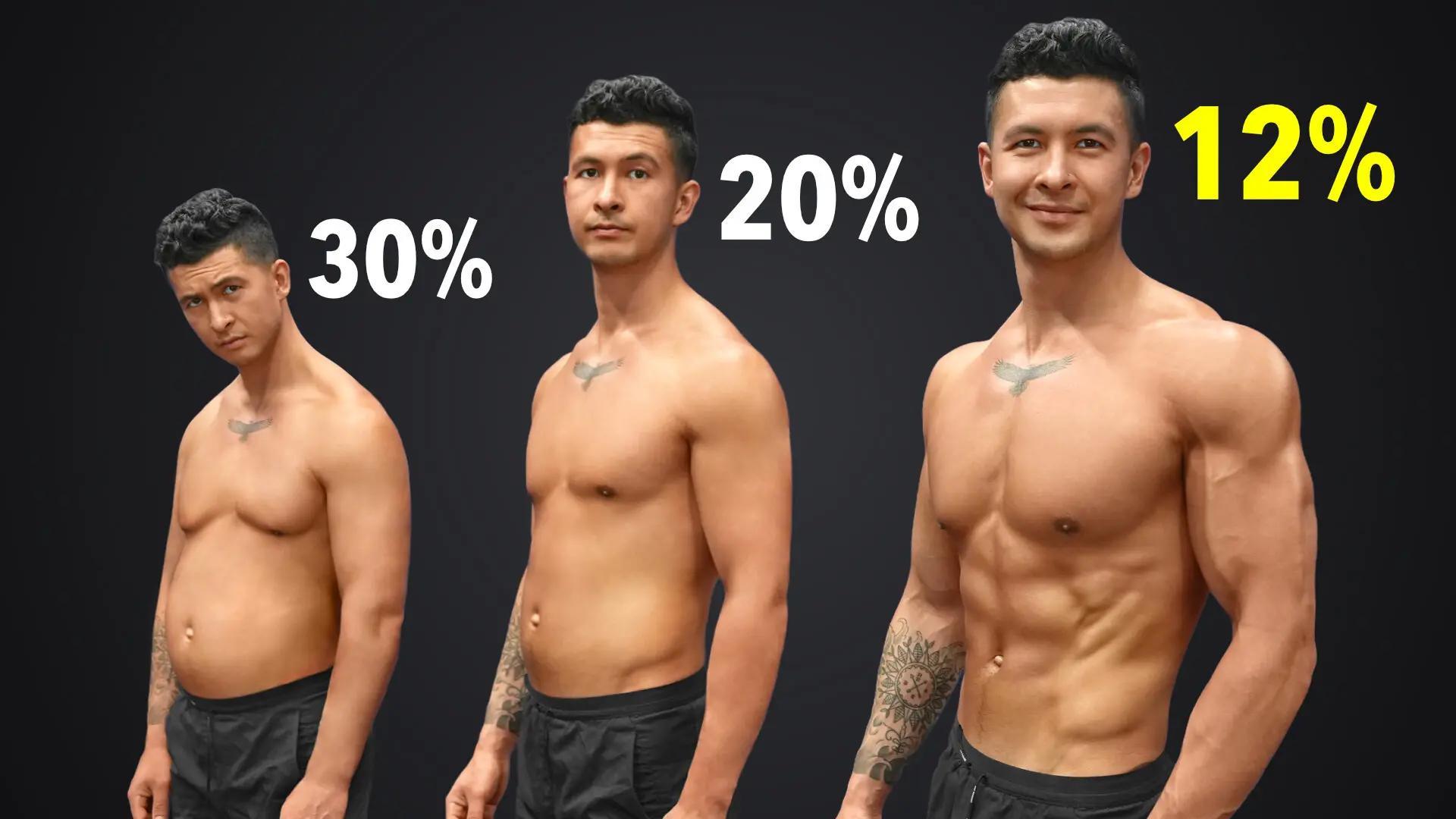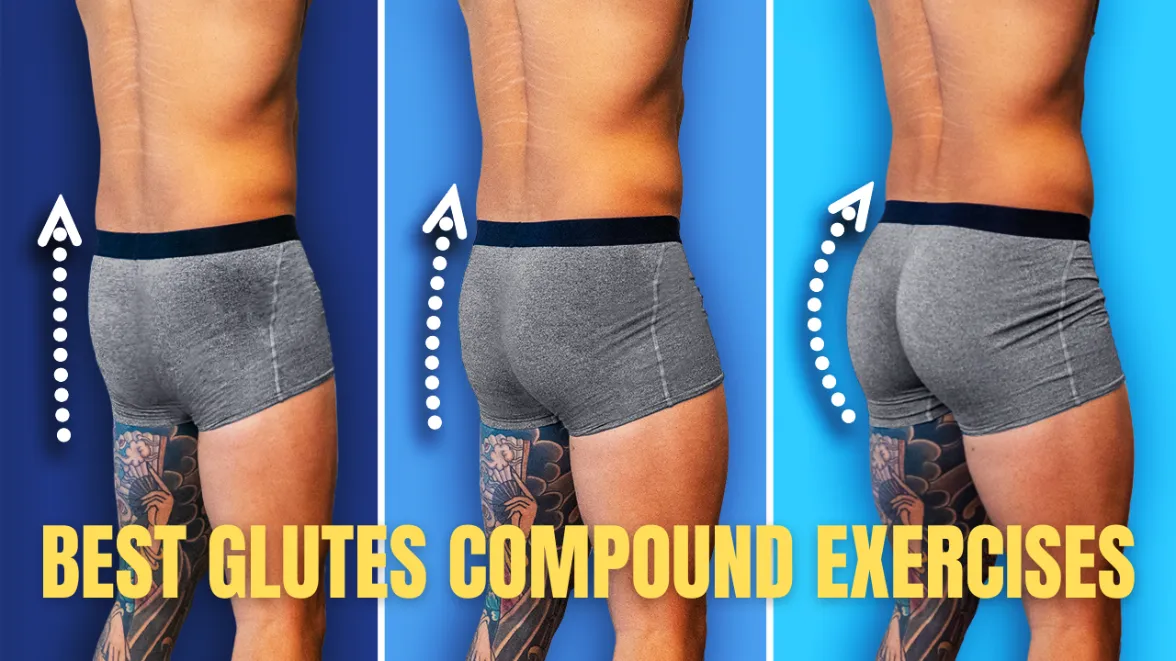
Glute Compound Exercises: Your Ultimate Guide
What Are Glute Compound Exercises?
Like all strength training movements, glute-building exercises fall under 2 categories:
- Compound exercises: These work multiple muscle groups across multiple joints. Examples of glute compound exercises include the barbell back squat (primary muscles worked: quads and glutes; joint action at the hips, knees, and ankles) and conventional deadlift (primary muscles worked: glutes and hamstrings; joint action at the hips, knees, and ankles).
- Isolation exercises: Also known as single-joint movements that tend to activate 1 specific muscle group in isolation — hence, the name. Examples of glute isolation exercises that only involve the hip joint include the cable glute kickback and the seated hip abduction (machine).
Hmm.
So, if compound exercises give you more “muscle-growing” action than isolation exercises (e.g., the barbell back squat grows your glutes and quads, compared to the glute-specific cable glute kickback) within a given set, why would anyone choose to do the latter?
That’s a great question.
But you’ll have to hold on to that thought because, first, let’s talk about …
How Do Glute Compound Exercises Help With Glute Hypertrophy?
To understand that, you’ll first need to know how hypertrophy — i.e., muscle growth — happens in the first place.
Now, historically, researchers, along with old-school bodybuilder legends and personal trainers, believed in 3 hypertrophy-driving mechanisms:
- One,muscle damage: Represents the microtrauma that training can inflict on muscle cells. It’s believed that the damage causes a reactive inflammatory response in the body that may explain muscle soreness (or “DOMS”) and cause the muscle to grow bigger in response.
- Two, metabolic stress: Forcing your muscles to work under low energy conditions (e.g., with little to no rest between sets or during blood flow restriction training) could cause metabolite accumulation, such as lactate and hydrogen ions, in muscle cells. This creates an acidic environment believed to kickstart a cascade of anabolic signaling for muscle growth. Ever felt that tight, burning sensation in your biceps after a biceps workout? Yep, you can thank metabolic stress for that.
- Three, mechanical tension: This represents the tension on your muscle as it lengthens and contracts under load. You can think of it as a band repeatedly stretching and shortening each rep. Let's say you perform the conventional deadlift. As you repeatedly lift and lower the barbell from/to the floor, it’s believed that the receptors in your working muscle fibers (including your quads and glutes) sense the applied forces — and convert the mechanical signals into chemical signals that stimulate various anabolic processes.
But as it turns out, there’s only 1 key hypertrophy driver we need to concern ourselves with: mechanical tension.
So, at this stage, you should have a pretty good idea of how glute compound exercises help with glute hypertrophy.
They essentially help create the tension you need on your glutes to stimulate muscle growth (note: this doesn’t just apply to glute compound exercises; glute isolation exercises also help make your glutes pop via the same mechanism). To illustrate:
- Deadlifts: maximum tension on the glutes at the bottom position
- Hip thrusts: maximum tension on the glutes at the top position
Benefits Of Doing Glute Compound Exercises
First things first.
Let’s set the record straight: compound and isolation exercises do equally well at eliciting muscle growth in a specific target muscle group when sets and reps are equated. However, compound exercises are often more time efficient since they help target multiple muscle groups at once.
For example, let’s say you want to work your glutes, quads, and hamstrings. Compare how long you'd take to complete your workout session if you only used ...
Compound exercises: assume you do 3 sets of each exercise, with each set lasting 45 seconds, and you rest for 3 minutes between sets
- Barbell back squat (glutes + quads)
- Romanian deadlift (glutes + hamstrings)
- Bulgarian split squat (glutes + quads)
Total workout time: 30 minutes 45 seconds
Isolation exercises: assume you do 3 sets of each exercise, with each set lasting 45 seconds, and you rest 2 minutes between sets
- Cable glute kickback (glutes)
- Donkey kick (glutes)
- Machine hip abduction (glutes)
- Seated leg curls (hamstrings)
- Leg extension (quads)
- Sissy squat (quads)
Total workout time: 47 minutes 30 seconds
Wow. 30 minutes 45 seconds vs. 47 minutes 30 seconds: that's a huge difference.
Glute compound exercises aren't just time efficient in that they activate different muscle groups simultaneously. They could also target multiple “heads” within a single muscle well.
See, instead of being 1 big muscle group, your glutes are made up of 3 different muscles:
- Gluteus maximus: The biggest, most visible, and most powerful glute muscle. Its primary function is hip extension (i.e., pushing your hips forward).
- Gluteus medius: The second biggest glute muscle located on the sides of your upper butt. It helps with hip stabilization and plays the primary function of hip abduction (i.e., moving your thigh away from your body’s midline).
- Gluteus minimus: The smallest glute muscle. Located just beneath the gluteus medius, the gluteus minimus shares many similar characteristics with the former — which means it also acts predominantly as a hip stabilizer and abductor.
So, a glute compound exercise that involves the hip extension and hip abduction, such as the curtsy lunge, would help activate all 3 glute muscles relatively well.
This is in stark contrast to an isolation exercise like the hip abduction machine. While it does a great job of working the glute medius, it doesn’t do a great job at hitting the biggest region - the gluteus maximus.
Glute Compound Exercises Aren’t The Be-All And End-All For Glute Hypertrophy
OK. Glute compound exercises have got a lot going on for them … which begs the question:
Why would anyone in their right mind still include glute isolation exercises (or isolation exercises in general) in their workout routine? There are 2 reasons:
- Very few glute compound exercises meaningfully target the gluteus medius and minimus (as you’ll see in a bit): If you wish to hit the training volume needed to grow them optimally, you'll need glute isolation exercises.
- Glute compound exercises tend to cause more central fatigue and joint stress than isolation exercises: Using a mix of compound and isolation exercises to hit the optimal training volume for your glutes may prove more enjoyable and sustainable over the long term.
Top 5 Glute Compound Exercises
#1: Barbell Back Squat
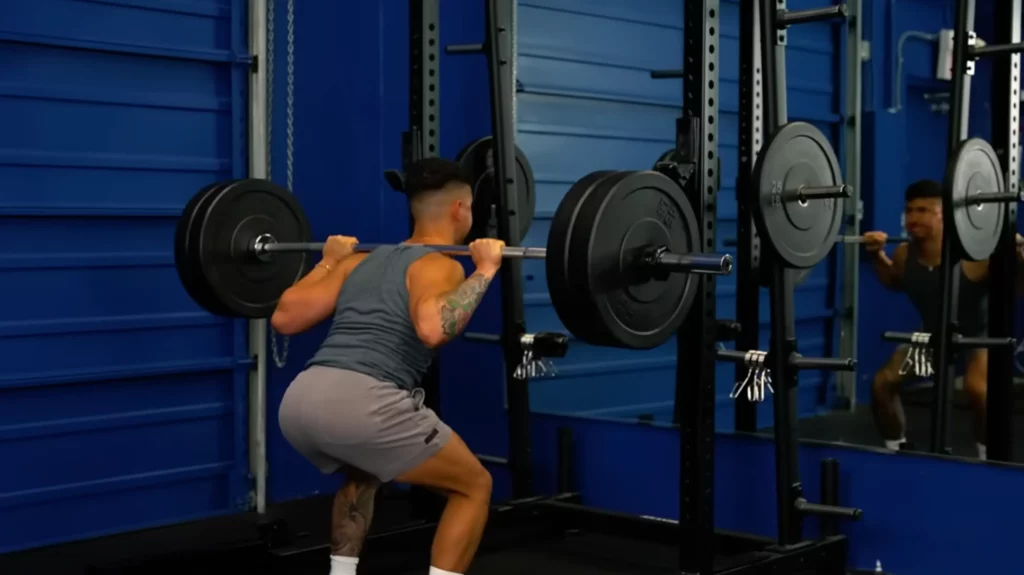
Equipment needed: Squat rack and a barbell
Preferentially targets: Gluteus maximus
What’s special about this exercise?
Just as it’s impossible to talk about building wider shoulders without mentioning lateral raises, the barbell back squat shouldn’t be overlooked if you’re trying to build big, round, and well-developed glutes.
While it’s true that you could increase glute activation by increasing the degree of hip extension on the movement (note: this translates to a more leaned-forward torso and vertical shin angle), I wouldn't recommend that you consciously tweak your squatting form.
Instead, focus on squatting in a way most suitable for your anatomy and mobility limitations (if any).
If you need help with that, I'd encourage you to check out this article on how to do the barbell squat properly for growth. I cover how you can find your ideal foot stance, the best bar placement, crucial breathing tips, and more.
#2: Conventional Deadlifts

Equipment needed: Barbell
Preferentially targets: Gluteus maximus
What’s special about this exercise?
Let’s be honest. Deadlifts just look super cool.
But, more than that, they’re also one of the best glute compound exercises around. They’re also relatively easy to progressively overload compared to an exercise like the barbell Romanian deadlifts, where you'd need to worry about losing grip and the increase in weight.
That said, deadlifts can be a problematic movement for many people. If you struggle with lower back pain or discomfort in general during the movement, you might want to check out this article I wrote on the proper deadlifting form.
#3: Glute-Focused Walking Lunges
Equipment needed: Dumbbells
Preferentially targets: Gluteus maximus
What’s special about this exercise?
Remember what I said about increasing the degree of hip extension to maximize glute activation?
Depending on your anatomy and mobility limitations (once again, if any), you might not find it possible to squat with a forward-leaning torso and vertically upright shins. Good news: you won’t run into that limitation with the glute-focused walking lunges.
With these, to maximize glutes activation, you’ll want to:
- Maintain a slight lean in your upper body while keeping your head in line with your body as you lunge, and
- Consciously think about stepping “forward” instead of stepping “up” after each lunge — use your front leg to propel and pull yourself forward.
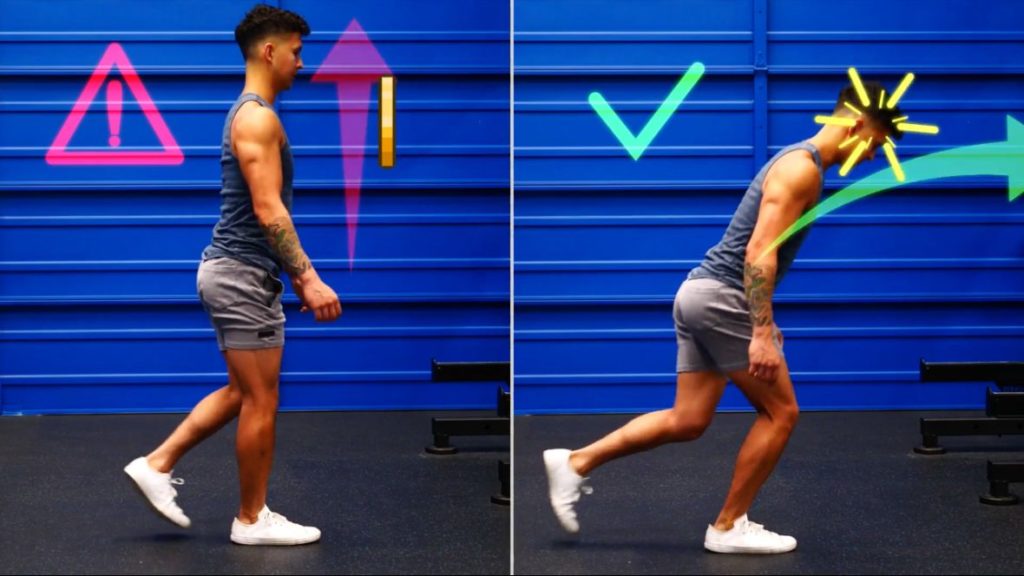
#4: Barbell Hip Thrust
Equipment needed: Barbell and a bench
Preferentially targets: Gluteus maximus
What’s special about this exercise?
Barbell back squat. Conventional deadlift. And the glute-focused walking lunges.
These exercises have something in common; can you guess what it is? That’s right. They challenge your glute muscles most when they’re in the lengthened position.
For optimal and well-rounded glute development, you'll want to incorporate an exercise with a complementary resistance profile. And this is where the barbell hip thrusts come into play.
These challenge your glutes the most when shortened at the top position.
And in addition to providing a complementary resistance profile, its movement pattern helps activate the entire gluteus maximus region well.
For context, your gluteus maximus can be somewhat divided into 2: the “upper glutes” and “lower glutes”. Glute exercises that feature the:
- Squat/lunge movement pattern (e.g., barbell back squat and glutes-focused walking lunges) — emphasize the lower glutes
- Hinge/pull movement pattern (e.g., conventional deadlifts) — emphasize the upper glutes
- Thrust/bridge movement pattern (e.g., barbell hip thrust) — emphasize upper and lower glutes
While you have the freedom of either using the PPT (this is where you’re looking down, scooping the weight up, and posteriorly tilting the pelvis into lockout) or the hinge method (this is where you keep your head, neck, and torso in alignment throughout the movement) to lift the barbell, in general, you'd still want:
- To squeeze your glutes hard till you achieve neutral or posterior tilted hips; avoid overextending, and
- Vertical shins at the top position, which happens by positioning feet not too close or too far away
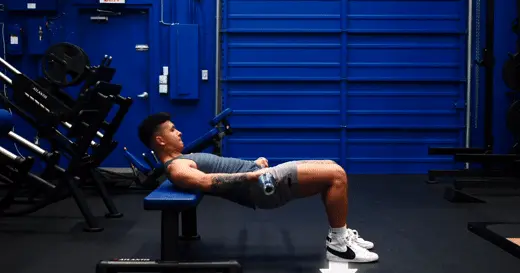
#5: Bodyweight Side Lying Hip Raise
Equipment needed: N/A
Preferentially targets: Gluteus medius and minimus
What’s special about this exercise?
As mentioned earlier, very few glute compound exercises target the gluteus medius and minimus.
The bodyweight side lying hip raise happens to be one of them.
Oh, and the cherry on top? They’re also a bodyweight exercise — meaning you can do them and grow your glutes from home!
To perform the bodyweight side lying hip raise:
- Start in a side plank position on your elbow with your hips and knees on the ground
- Push through the grounded knee; push as tall as you can and aim to achieve maximal hip separation
- When you’re at the top, drive the hips forward and, at the bottom, sink your hips back; that’s 1 rep
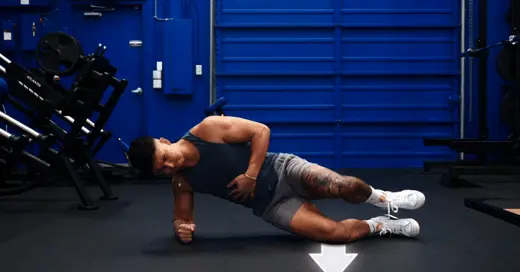
Glute Compound Exercises For Beginners
Just getting started on your fitness journey? No worries. Here are 5 beginner-friendly glute compound exercises you could do.
#1: Glute-Focused Leg Press
Equipment needed: Leg press machine
Preferentially targets: Gluteus maximus
What’s special about this exercise?
Barbell back squats are hard.
A regression exercise you could use to target your glutes while you refine your barbell back squat technique is the leg press, which allows you to:
- Learn the squatting motion and build the necessary strength and "muscle memory" in your glutes and quads — potentially easing your progression to barbell back squats when the time comes.
- Safely increase the amount of hip extension and, in turn, glute activation without worrying too much about your anatomical and/or mobility limitations (you can do so by placing your feet higher on the platform and stopping each rep once your knees hit 90 degrees).
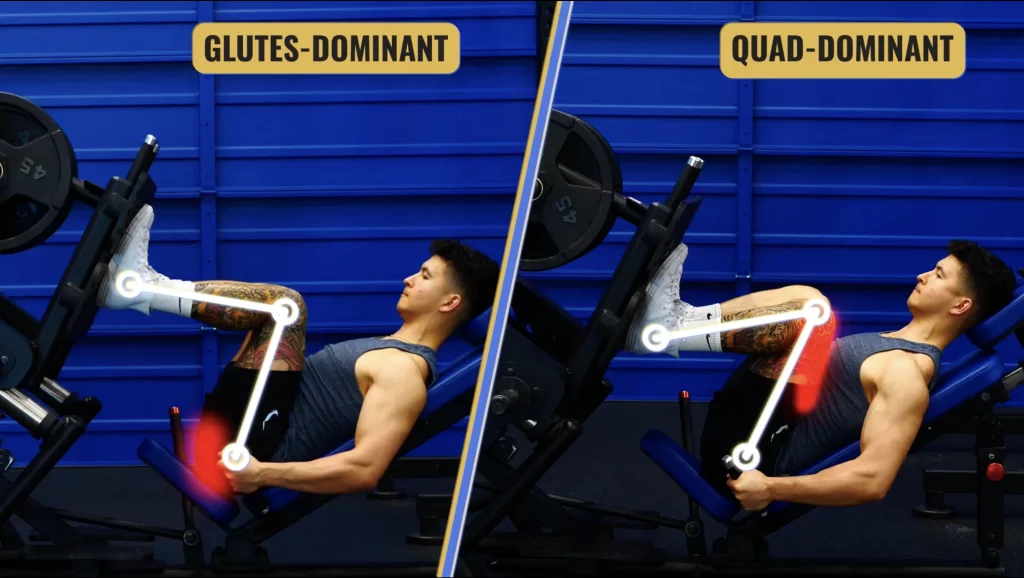
#2: Bodyweight 45-Degree Hip Extensions
Equipment needed: 45-degree hip extension machine
Preferentially targets: Gluteus maximus
What’s special about this exercise?
Like the barbell back squat, conventional deadlifts can be technically challenging.
So, I'd recommend you first master the hip hinge motion through the bodyweight 45-degree hip extension. To maximize glutes activation on the exercise:
- Flare your feet out (turn them 45 degrees “outwards”)
- Round over at the spine fully to shut down the lower back muscles
- Think of driving your hips into the pad as you contract your glutes

You could then progress by adding weight plates or barbells to the mix. Note: instead of rounding, maintain a neutral spine when you do weighted 45-degree hip extensions — this is much safer for your lower back.
#3: Static Lunges
Equipment needed: Dumbbells
Preferentially targets: Gluteus maximus
What’s special about this exercise?
Think of static lunges as a regression exercise for walking lunges; you won’t have to spend so much time and attention trying to stay balanced. Once again, though, you’ll want to:
- Maintain a slight forward lean in your torso (~20 degrees)
- Take a stride length such that your shin angle at the bottom of the movement is as vertically upright as possible
- Focus on pushing through the heel
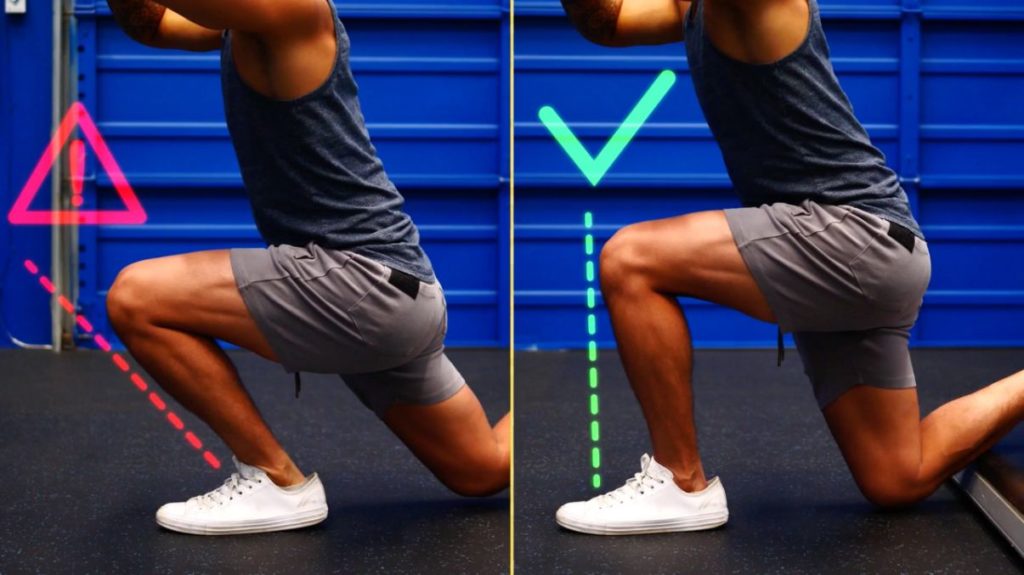
#4: Foot-Elevated Glute Bridges
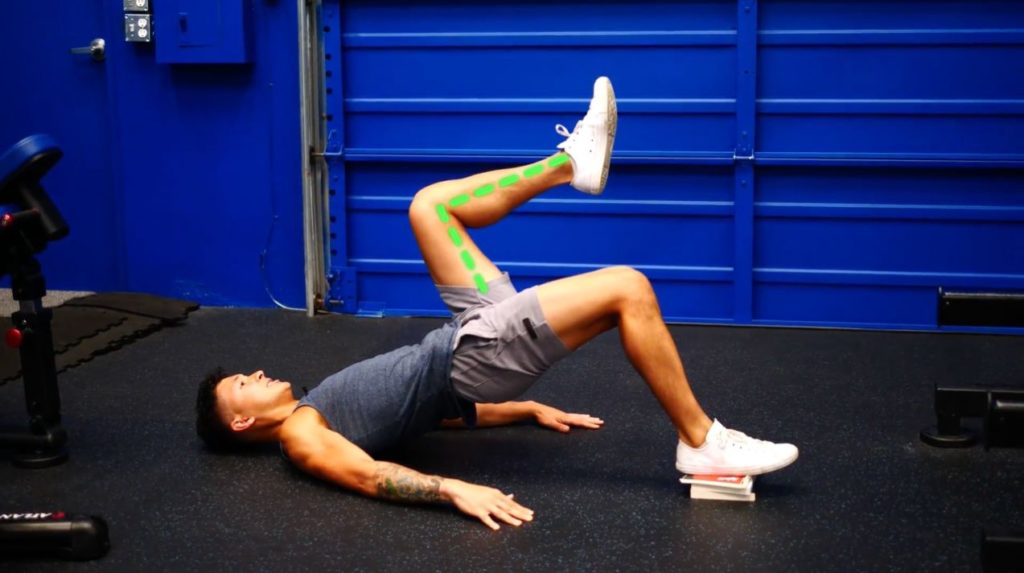
Equipment needed: Step board
Preferentially targets: Gluteus maximus
What’s special about this exercise?
Think of these as a regression exercise for the barbell hip thrusts. To perform these:
- Elevate your feet onto a step board.
- Position your body so that you can maintain a ~90-degree angle in your knees at the top position.
- Focus on squeezing your glutes with each rep.
You could place dumbbells or barbells on your hip region to progressively overload.
#5: Seated Machine Hip Abductions
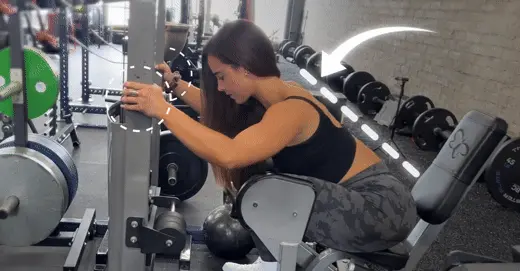
Equipment needed: Hip abduction machine
Preferentially targets: Gluteus medius and minimus
What’s special about this exercise?
Remember the bodyweight side lying hip raises we talked about earlier?
Yes, they help target the gluteus medius and minimus. But just because it’s a bodyweight glute compound exercise doesn't mean it’s easy.
In fact, it’s incredibly challenging because you must stay in a side plank position throughout the movement, which means your core might burn out before you’ve even meaningfully worked your glutes (this is especially so if you haven’t been training your core!)
So, a slightly less demanding glute exercise you could use is the seated machine hip abductions. Notice how I didn’t say “glute compound exercise? Yep … that’s because, strictly speaking, the seated machine hip abduction is an isolation exercise.
The truth is that there aren’t any “beginner-friendly” glute compound exercises that’ll help meaningfully activate the gluteus medius and minimus.
Advanced Glute Compound Exercises
#1: Glutes-Focused Bulgarian Split Squats
Equipment needed: Dumbbells and a bench
Preferentially targets: Gluteus maximus
What’s special about this exercise?
Bulgarian split squats: universally dreaded but so incredibly effective at building your glutes.
That’s because they help you get a much deeper stretch in the glutes at the bottom position — allowing you to take advantage of what’s known as “stretch-mediated hypertrophy” for potentially more glute gains.
But as with lunges, make sure to:
- Maintain a slight forward lean in your torso (~20 degrees) and a neutral back
- Take a wider stance such that your shin angle at the bottom of the movement is as vertically upright as possible
- Focus on pushing through the heel

#2: Banded Barbell Romanian Deadlift
Equipment needed: Squat rack, barbell, and a resistance band
Preferentially targets: Gluteus maximus
What’s special about this exercise?
With the conventional deadlifts, there’s a ton of tension on your glutes as you move through the bottom- to mid-range of the movement, but none at the top position.
By allowing you to "lean forward" into the movement, the banded barbell Romanian deadlift allows you to experience relatively consistent tension on your glutes as they repeatedly lengthen and contract.
Now, with these, ensure you've got a good grip on the technique before taking on the "big weights". I'd recommend just starting with the bare barbell.
#3: Modified Curtsy Lunge
Equipment needed: Dumbbells and a weight plate
Preferentially targets: Gluteus medius and minimus
What’s special about this exercise?
This is a unique type of lunge I learned from Coach Kassem that turns out to activate the glute medius and minimus very well. To perform these:
- Use a small step up for the front foot (you can use a 45 lb weight plate for this)
- Turn in the toe of your front foot slightly
- Step back and slightly to the side behind the body instead of simply stepping directly back
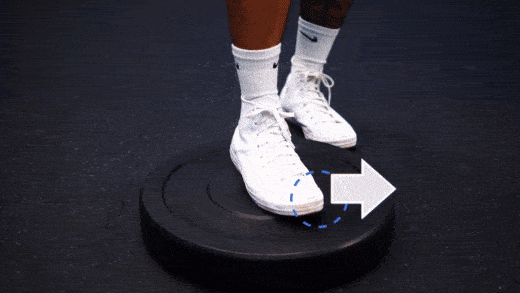
Glute Compound Exercises Without Equipment
If you don’t have access to equipment, here are 3 of the best bodyweight glute compound exercises to do:
- One,lunges (gluteus maximus): Once again, tweak your torso and shin angle to maximize glute activation.
- Two, single-leg hip thrusts (gluteus maximus): Ideally, you should find a stack of books. Flatten your back against the floor. Next, place one foot on the stack of books with the other leg straight. From here, push up against the stack of books while raising the opposite leg to 90 degrees. Avoid excessively arching your back as you do so.
- Three, reverse hyperextensions (gluteus maximus): You could do these on a sofa or a countertop. If you have a tall surface, you can do straight legs, starting narrow at the bottom and ending wide at the top. But if you're working with a low surface (e.g., a sofa), you could bend your legs at the bottom and kick the legs at the top.
Common Mistakes To Avoid When Doing Glute Compound Exercises
Common mistakes when doing glute compound exercises include:
- Letting the quads take over: As mentioned earlier, this can be easily and quickly fixed by tweaking your torso and shin angle on the leg press and various lunging exercises.
- Rounding the back: This shifts the tension to your lower back and increases your risk of injury. Always maintain a neutral spine.
- Neglecting glute activation: Some people, especially those who sit a lot, will have difficulty activating and feeling their glutes working. If you can relate, don't forget to include glute activation exercises within your routine to “awaken” your glutes so they show up — all primed for growth — during your glute workouts.
How Many Reps And Sets Should I Do For Glute Compound Exercises?
The number of sets you should do per workout session depends on your lifting experience; if you’re a:
- Beginner lifter: You’ll need 6 to 10 working sets per week for optimal glute hypertrophy (so, if you train 3x a week, that’ll be 2 to 3 sets per session)
- Experienced lifter: You’ll need 16 to 20 working sets per week for optimal glute hypertrophy (so, if you train 3x a week, that’ll be 8 to 10 sets per session; research suggests anything >10 sets per session is “junk volume”)
As for the number of reps? Here’s what I usually recommend; note that this applies to all exercises — not just glute-specific exercises:
- 15% to 20% of sets: 2 to 6 rep range
- 15% to 20% of sets: 12 to 15+ rep range
- 60% to 70% of sets: 6 to 12 rep range
If you’re wondering about my rationale, check out this part article I wrote on rep ranges.
How To Incorporate Glute Compound Exercises Into Your Workout Routine
Here are a few sample workout routines depending on your lifting experience and/or equipment availability:
General
#1: Barbell Back Squat (3 sets, 6 to 8 reps)
#2: Barbell Hip Thrust (3 sets, 6 to 8 reps)
#3: Bodyweight Side Lying Hip Raise (3 sets, 10 to 15 reps per side)
Beginner
#1: Glute-focused Leg Press (3 sets, 8 to 12 reps)
#2: Bodyweight 45-Degree Hip Extensions (3 sets, 8 to 12 reps)
#3: Banded Walking Abductions (3 sets, 10 to 15 reps)
Advanced
#1: Banded Barbell Romanian Deadlift (3 sets, 6 to 8 reps)
#2: Bulgarian Split Squats (3 sets, 8 to 12 reps per leg)
#3: Modified Curtsy Lunge (3 sets, 8 to 12 reps per leg)
At-home workout
#1: Single-leg hip thrusts (3 sets, 8 to 12 reps per leg)
#2: Static Lunges (3 sets, 10 to 15 reps per leg)
#3: Bodyweight Side Lying Hip Raise (3 sets, 10 to 15 reps per side)
Before you copy-paste these into your workout routine, here's a disclaimer.
As mentioned throughout this article, relying on glute compound exercises isn’t likely to provide well-rounded glute development. You’ll also need to sprinkle in select glute isolation exercises to bring up specific lagging parts.
Interested in learning what those are and how to seamlessly integrate them into a workout routine that transforms your physique (not just your glutes!) in the most time-efficient manner?
Then look no further than the Built With Science programs.
These science-based, step-by-step training programs show you exactly what to do — from exercise selection to recovery to nutrition planning — so you’re primed for success.
To discover the best program for you and your body, take my free analysis quiz below:
Click the button below to take my analysis quiz to discover the best program for you:
↓



